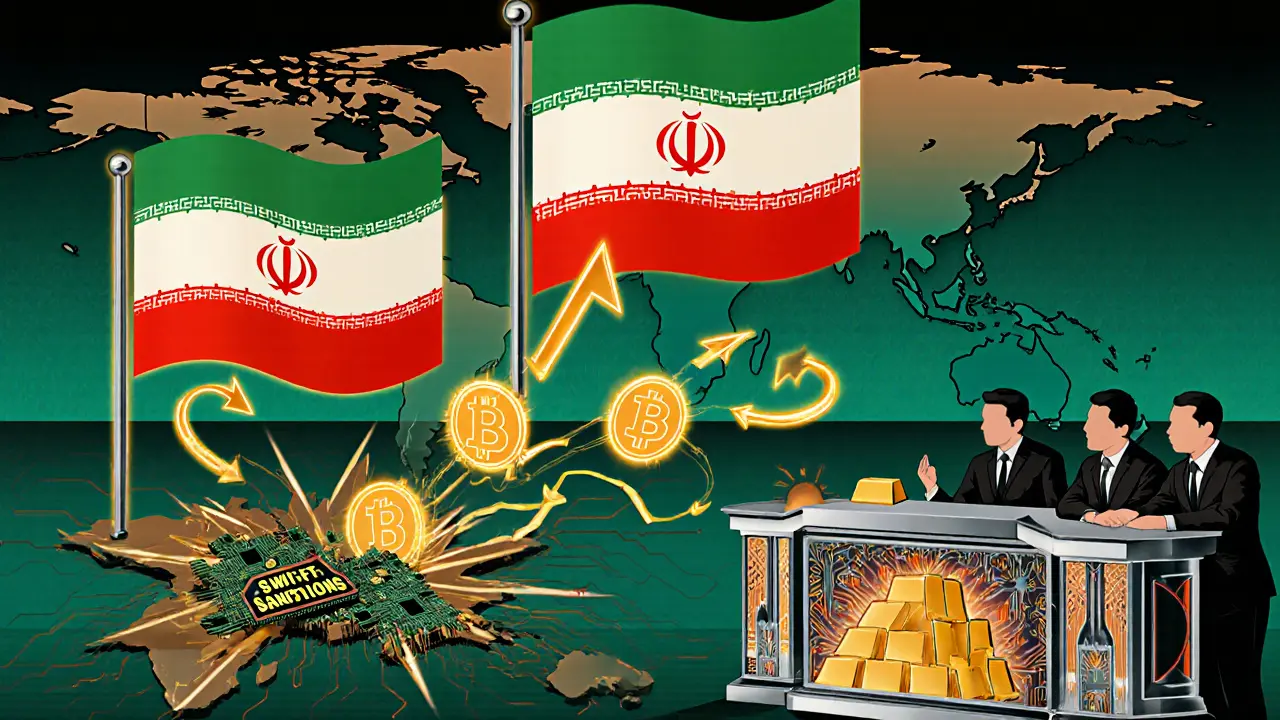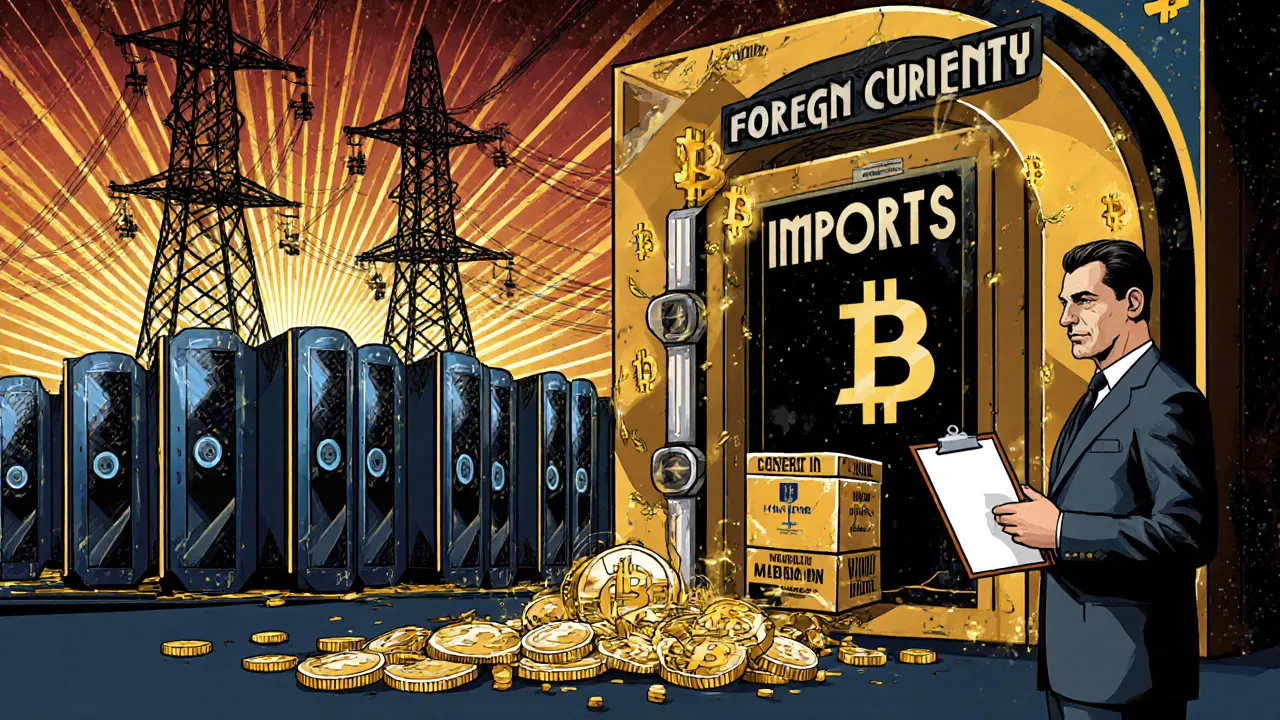Bitcoin Import Estimator for Sanctions Evasion
This calculator estimates how much foreign currency Iran can generate from Bitcoin mining operations and what imports could be funded, based on the article's analysis of Iran's state-controlled cryptocurrency infrastructure.
Estimated Results
Iran isn’t waiting for permission to trade. When banks cut it off from the global financial system, it built its own. Bitcoin became the tool - not for speculation, but survival. By 2025, the country has turned crypto mining into a state-backed industrial operation, using cheap electricity and foreign demand to fund imports that sanctions would otherwise block. It’s not a loophole. It’s a system.
How Bitcoin Bypasses Sanctions
The U.S. and EU froze Iran’s access to SWIFT, blocked dollar transactions, and restricted access to international banks. Traditional trade routes collapsed. But Bitcoin doesn’t need banks. It doesn’t need permission. It moves across borders in minutes, with no intermediary to say no. Iran’s solution? Mine Bitcoin domestically, then sell it abroad for goods. The Central Bank of Iran doesn’t let citizens pay for groceries with crypto. But it does let state-approved miners convert their Bitcoin into foreign currency - and use that to buy medicine, machinery, and food from overseas. The crypto isn’t used as money inside Iran. It’s used as a bridge to the outside world. The first major import using crypto happened in August 2024: a $10 million order of industrial equipment. No bank. No dollar. Just a digital transfer from a foreign buyer to an Iranian mining pool, then a trade order placed through a licensed intermediary. It worked. And since then, dozens more have followed.The Mining Machine Behind the Trade
Iran doesn’t just mine Bitcoin - it scales it like a factory. By 2025, over 10,000 licensed mining farms operate across the country. Most are massive, industrial setups with thousands of ASIC miners humming in warehouses, powered by state-subsidized electricity. One 175-megawatt facility in Rafsanjan, linked to the Islamic Revolutionary Guard Corps, runs like a power plant for crypto - consuming more electricity than some small countries. The government doesn’t just allow this. It directs it. The Ministry of Energy assigns electricity quotas. The Central Bank approves which mining pools can export Bitcoin. The Cyber Police monitor transactions to prevent money laundering. This isn’t underground. It’s institutional. Miners must register with the state, document every coin they mine, and only sell to approved channels. The Bitcoin they produce doesn’t go to individuals. It goes to state-controlled trading desks that exchange it for euros, yuan, or gold-backed assets - then use those to pay foreign suppliers.Who Controls the Flow?
This isn’t a free market. It’s a state monopoly disguised as regulation. The Islamic Revolutionary Guard Corps (IRGC) and affiliated religious foundations control the largest mining operations. These groups don’t pay electricity bills. They get priority power. They have armed guards. They operate in special economic zones, shielded from oversight. Astan Quds Razavi, a powerful religious foundation, runs one of the biggest mining networks. Investigators call it a “crypto cartel.” These entities don’t just mine Bitcoin - they use it to fund military procurement, bypassing U.S. sanctions on defense equipment. Binance, the world’s largest crypto exchange, processed over $8 billion in Iranian transactions between 2018 and 2024. Many of those trades were linked to IRGC-affiliated entities. Even when Iran temporarily banned mining in 2021 during a national power crisis, the ban lasted weeks - and only targeted small, home-based miners. The big operations? They kept running.
Trade Partners and Global Networks
Iran didn’t build this system alone. It partnered with countries that also face sanctions. Russia signed a formal crypto cooperation deal in 2018. Iran has negotiated similar agreements with China, Turkey, and several European nations. The goal? Create a parallel trade network that avoids the dollar. In practice, this means a Russian company sells oil to Iran using Bitcoin. Iran uses that Bitcoin to buy pharmaceuticals from India. India gets paid in crypto, then converts it to rupees through a local exchange. No U.S. bank touches the money. No SWIFT message is sent. The transaction is invisible to Western regulators. Even countries like Austria and Switzerland, which aren’t under sanctions, have quietly become intermediaries. Their banks don’t deal with Iran directly - but they’ll process crypto payments from Iranian-linked entities if the source isn’t flagged.The Hidden Cost: Power Blackouts and Public Anger
There’s a price. And it’s paid by ordinary Iranians. In cities like Tehran and Isfahan, power outages last up to 12 hours a day. Factories shut down. Refrigerators go empty. Hospitals run on generators. Meanwhile, crypto mining farms - many owned by the IRGC - consume up to 5% of the country’s total electricity. Some farms use more power than entire provinces. The government says it’s cracking down on illegal miners. And it has - arresting hundreds of citizens who used household electricity to mine Bitcoin. But state-linked miners? They’re untouched. The disparity has fueled public anger. Protesters have taken to the streets, blaming the regime’s crypto obsession for the blackout crisis. The Central Bank admits the strain. But it argues the trade benefits outweigh the costs. Without crypto imports, Iran would struggle to import basic medical supplies. The government estimates that over 30% of its critical imports now rely on crypto-backed transactions.
Is It Sustainable?
The system works - for now. But it’s fragile. Bitcoin’s price swings make planning hard. A $1 million order might cost $1.2 million tomorrow if the price jumps. Iran’s traders use stablecoins like USDT to reduce risk, but even those aren’t foolproof. Exchange platforms can freeze accounts. Wallets can be seized. International pressure on crypto firms to block Iranian transactions is growing. The energy problem is worse. Iran’s grid can’t handle this level of demand long-term. Renewable energy is scarce. The country relies on aging fossil fuel plants. If the power grid collapses, so does the mining industry - and with it, the import system. And then there’s regulation. In 2025, the Central Bank ordered all crypto exchanges to shut down rial payment gateways and get new licenses. Many smaller exchanges closed. The ones that survived are now tightly controlled. The state is tightening its grip, not loosening it.What This Means for Global Trade
Iran’s experiment isn’t unique. Venezuela, North Korea, and Russia are all testing crypto for sanctions evasion. But Iran is the most advanced. It’s the only country with a full regulatory framework, state-owned mining infrastructure, and coordinated trade channels built around digital assets. It proves one thing: when you cut off a nation from the global financial system, it will find another way. Bitcoin isn’t magic. But it’s the only tool that works at scale - without a central authority to shut it down. For businesses looking to trade with Iran, the path is clear: work through licensed crypto intermediaries. Don’t try to send Bitcoin directly. Don’t use unregulated exchanges. The risks are high - and the penalties, even higher.What’s Next?
Iran is now testing blockchain-based smart contracts for import orders. Instead of relying on human intermediaries, the system will automatically release payment when goods are verified at the border. It’s still experimental. But if it works, it could cut delays from weeks to hours. Meanwhile, Western regulators are scrambling. The U.S. Treasury has added several Iranian crypto exchanges to its sanctions list. The EU is pushing for global rules to track crypto flows from sanctioned nations. But the technology moves faster than the laws. Iran’s crypto trade network won’t disappear. It’s too useful. Too embedded. Too vital to the country’s survival. The real question isn’t whether crypto can bypass sanctions. It’s whether the world is ready to accept that it already has.Can individuals in Iran use Bitcoin to buy imported goods?
No. The Central Bank of Iran bans the use of cryptocurrency for domestic payments, including consumer imports. Only state-licensed mining pools can convert mined Bitcoin into foreign currency, which is then used by government-approved importers to pay overseas suppliers. Ordinary citizens cannot buy medicine or electronics directly with Bitcoin.
Why does Iran allow Bitcoin mining but ban its use as currency?
Iran allows mining because it turns cheap electricity into foreign currency. The country has abundant natural gas and low electricity rates, making it one of the cheapest places in the world to mine Bitcoin. But allowing Bitcoin as a currency would risk capital flight, inflation, and loss of control over the rial. By keeping mining and trade separate, the state controls the flow of money - mining generates revenue, and the government decides how it’s spent.
How much Bitcoin does Iran mine each year?
Iran produces nearly 5% of all new Bitcoin globally - roughly 8,000 to 9,000 BTC annually. That’s worth over $500 million at current prices. Most of this is sold to foreign buyers through licensed channels and used to fund imports. Mining revenue is estimated at $1 billion per year, making it one of Iran’s top export earners.
Are Iranian crypto transactions traceable?
Yes - but only within Iran’s system. All licensed mining pools must register with the Central Bank and log every transaction. The government tracks the flow of Bitcoin from mine to export. However, once Bitcoin leaves Iran through overseas exchanges, tracing becomes harder. Many transactions are routed through non-KYC platforms or mixed with other users’ funds, making it difficult for foreign regulators to identify Iranian origins.
Can foreign companies legally trade with Iran using Bitcoin?
Technically, no - if they’re subject to U.S. or EU sanctions. Most major exchanges and payment processors block Iranian users. However, some smaller, non-Western exchanges still process these trades. Foreign companies that engage in such transactions risk penalties, asset freezes, or being cut off from global banking. Many use intermediaries in third countries to obscure the connection.
What happens if Iran’s power grid fails?
If the grid collapses, Iran’s entire crypto import system could stall. Mining requires constant, massive power. Without it, Bitcoin production drops - and so does foreign currency inflow. The government has no backup plan. Some experts warn that Iran may soon be forced to choose between keeping the lights on for homes or keeping the miners running for trade. So far, it’s chosen the latter.



